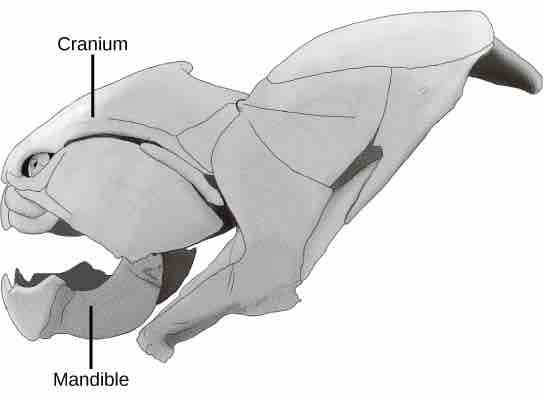Craniata and Vertebrata
The clade Craniata is a subdivision of Chordata. Members of Craniata posses a cranium, which is a bony, cartilaginous, or fibrous structure surrounding the brain, jaw, and facial bones . The clade Craniata includes all vertebrates and the hagfishes (Myxini), which have a cranium but lack a backbone. Hagfish are the only known living animals that have a skull, but not a vertebral column .
Hagfish
Although it lacks a backbone, the hagfish is a member of the Craniata clade because it possesses a bony skull.

Clade Craniata
Craniata, including this fish (Dunkleosteus), are characterized by the presence of a cranium, mandible, and other facial bones.
Vertebrates are members of the subphylum Vertebrata, the clade Craniata, and the phylum Chordata. Vertebrates display the four characteristic features of chordates, but they are named for the vertebral column composed of a series of bony vertebrae joined together as a backbone . In adult vertebrates, the vertebral column replaces the embryonic notochord.

Vertebrates
Vertebrata are characterized by the presence of a backbone, such as the one that runs through the middle of this fish. All vertebrates are in the Craniata clade and have a cranium.
Vertebrate Evolution
In the phylum Chordata, the closest relatives of the vertebrates are the invertebrate chordates. Based on the molecular analysis of vertebrate and invertebrate genomes (genomics), scientists can determine the evolutionary history of different phylogenetic groups.
According to these genomic analyses, vertebrates appear to be more closely related to the lancelets (cephalochordates) than to the tunicates (urochordates). This suggests that the cephalochordates first diverged from urochordates, and that vertebrates subsequently diverged from the cephalochordates. This hypothesis is further supported by the fossil of a 530 million-year-old organism with a brain and eyes like a vertebrate, but without the skull found in a craniate. A comparison of the genomes of a lancelet, tunicate, lamprey, fish, chicken, and human confirmed that two whole-genome duplications occurred in the early history of the Vertebrata subphylum.
Both fossil and genomic evidence suggests that vertebrates arose during the Cambrian explosion.The Cambrian explosion was the relatively brief span of time during the Cambrian period during which many animal groups appeared and rapidly diversified. Most modern animal phyla originated during the Cambrian explosion.